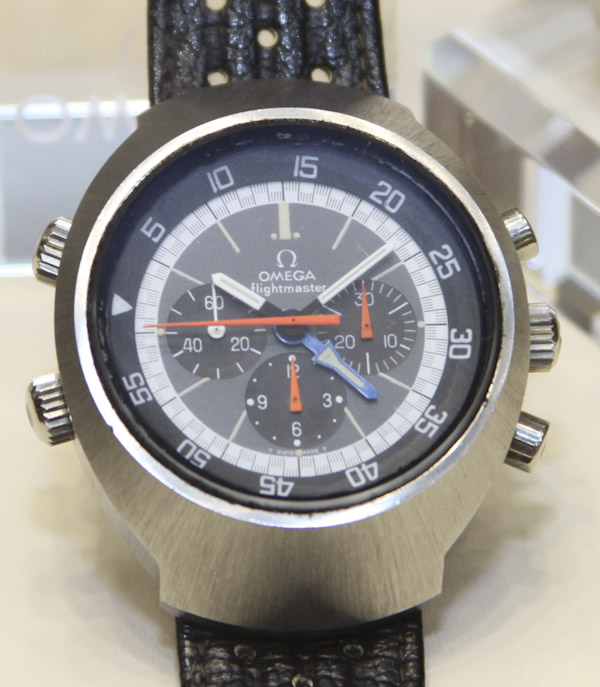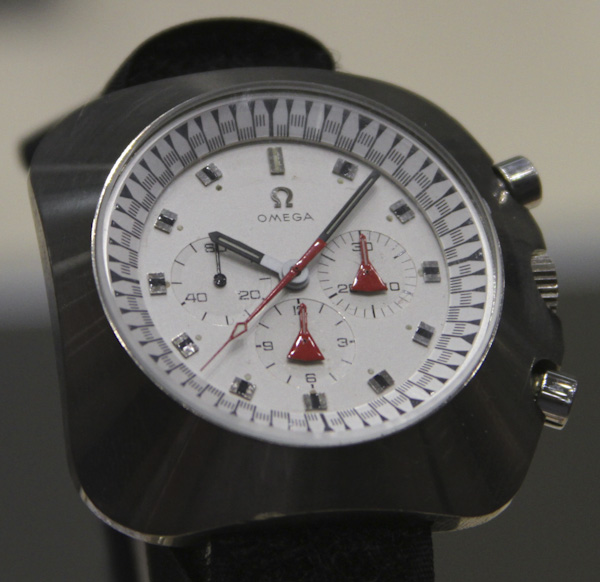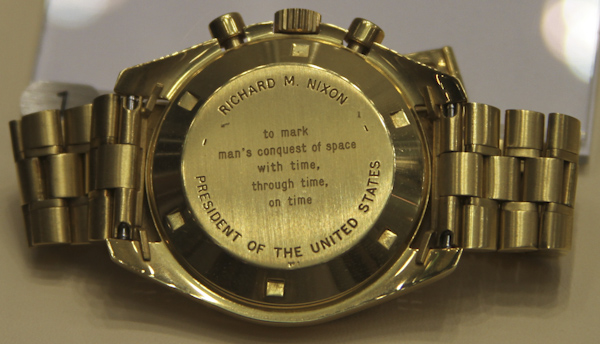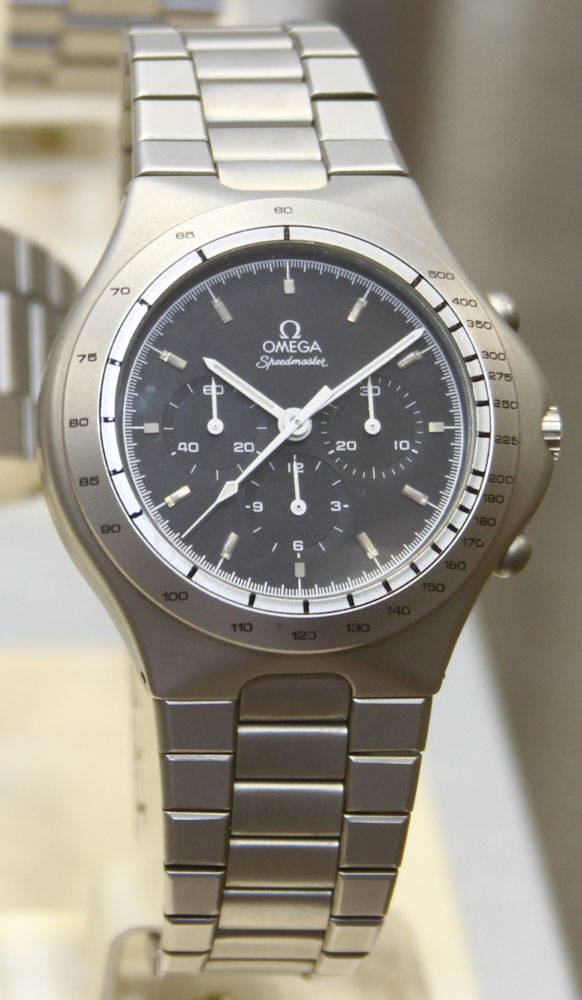
Significant Models
Up until the 1950s the most popular Omegas featured the legendary 30mm hand-wound calibres. 30mm denotes the size of the movement, not the case. Produced in the millions, the 30mms (30T2 and 2XX series calibres being the most common) were robust, reliable, accurate, and easy to service. They formed a solid base for chronometer modifications as well, and today chronometer variants (with unique balance assemblies, indexes, and finely-finished gears that set them apart from base calibres) are the most desirable. Any 30mm is worth something. They were produced in cases that ranged from 32-33mm up to a pretty sizable 38mm (which looks even bigger due to the expansive dials and thin bezels). The larger sizes command a premium and are a bit harder to find, but are worth seeking out – they are elegant dress watches that are big enough to not feel out of place in a sea of 40mm plus designs. While fairly valuable, the 30mm variants are not that rare – again, they made millions of them over the decades. Finding a good, original one is not that difficult, but beware of scores of dodgy refinished dials and worn-out cases. It’s also a movement that is prone to neglect as it can run for years without attention, which means many will need a service pronto.
From the 1950s onward automatic calibres became popular, starting with the famous “bumper” calibres. Early automatics had a rotor that rotated a partial circle, not a full rotation, and were buffered by a blocking bridge with small springs on either side. When the rotor swings back and forth it bounces off the springs, hence “bumper”. This “Harwood” system, named for the inventor who developed it, was used by many brands until the 1960s due to the fact that Rolex held the main patents on the 360-degree rotor system. The most famous of the bumpers was the first generation Seamaster introduced for the 1948 London Olympics – at the time it was considered a sporty watch, with thick lugs and a water resistant case. Today it would be considered a dress watch. Generally they are not as collectible as earlier 30mms but have their own following. Up until the 1970s Seamasters were generally dressy designs, more akin to the modern Aqua Terra than the Seamaster Professional, with a few notable exceptions.

In 1957 the Seamaster 300 was released, a proper dive watch with a robust automatic movement (5XX series calibres), highly water resistant case (200 meters, despite what the “300” moniker suggests), highly legible luminescent dial and hands, and a rotating graduated bezel. It was a competitor to the Rolex Submariner, though it never achieved nearly as much success or collectibility. Early one had a narrow bezel, later models sported a bigger version with a luminescent acrylic insert. Today it is a popular but rather uncommon collectible, and highly wearable – it clocks in at a very modern 42mm, which was gigantic for a watch of this era, and considerably bigger than the 39-40mm Submariner. These command higher than average prices due to their rarity and style, but they never come close to Rolex territory, so it’s an affordable choice for a sexy vintage diver that is big enough to wear everyday. Speaking of big, there is also the Ploprof Seamaster 600 (not to be confused with the Seamaster 600 dress watch) that has found new popularity since it was re-released by Omega several years ago. It’s a massive, purpose-built diver with a one-piece case and locking bezel with a button release. Some smaller (but still sizable) divers were released following the Ploprof, including the “SHOM” models. These have a dedicated following, but prices remain accessible. Fun fact – the Seamaster Planet Ocean is a recreation of the first generation 1957 Seamaster 300, right down to the broadarrow hands, Arabic numerals, and thin bezel insert.
Also released in 1957 was the Speedmaster chronograph, the king of vintage Omegas. The first generation (called “broad arrow” due to its wide arrow-tipped hands) had an engraved metal tachymetre bezel and a 40mm “straight lug” case; by the 1960s they had adopted the style we recognize today (because it is still in production after over 50 years), with white-painted baton hands, black printed tachymetre insert, and a 42mm case with crown guards and twisted lyre lugs. From 1957 to 1968 they utilized the 321-calibre movement, a column-wheel chronograph based on a Lemania design; from 1968 to present they have used the 861-calibre (later 1861) which has a shuttle-cam system and more refined design. The 321 models are the most desirable, more so if they are straight-lug or broad-arrow models. 861s are far more common and make a bargain purchase for a vintage hand-wound chronograph, often coming up for under 2 grand for a good example. You couldn’t buy a BEZEL for an equivalent Rolex Daytona at that price, and the Daytona is a downright puny 37mm. Everyone needs to have a Speedmaster in their collection at some point, it is one of the best classic chronographs out there and its history in the space program means it is a great conversation starter. This watch was worn on the MOON dontchaknow…

Yet another 1957 release – the Railmaster anti-magnetic models. Short lived and never particularly popular, the Railmaster has become a pretty serious collectible in recent years. Like any good collectible, it was a flop and was produced in limited numbers. The Railmaster features a manual wind 2XX calibre (30mm) movement encased in a Faraday cage of soft iron, with a soft iron dial as well, to shield it from heavy magnetic fields. It’s a concept that was also used by IWC with the Ingenieur, and Rolex with the Milgauss. The Railmaster shared styling with the Ranchero, featuring a black luminescent dial with broad-arrow hands on most models. It came in a 36mm stainless steel case. Expect to pay big money for a clean, original Railmaster – anywhere from $7000 up. Some have cleared $10 or even $20K at auction.
Two significant models that are building a serious following are the military-issue 1945 WWW, RAF ’53 and the very rare RCAF chronograph. The RAF 53 was made for a single year for the British air force, and features a 30mm manual wind calibre with centre seconds in a 37mm steel case with fixed lug bars. Dial is a simple black luminescent affair with Arabic numerals and broad sword hands. An earlier series was issued during the Second World War (1945) that had sub-seconds at 6 oclock and a 35mm case. These models are commonly known as W.W.W.s – Wrist Watch Waterproof, as per the military contract. The RCAF chronograph was produced for the Canadian air force, in two issues (1960 and 1962). They were mostly unmarked, featuring a plain white dial with no indication it was made by Omega until you opened it up and checked the movement (some dials do have an Omega logo near 12 oclock). The 1960 edition was 36mm, the ’62 38mm. Again, steel cases with fixed lug bars, as per usual military specs. These models are becoming increasingly sought after, but beware – fakes and redials abound!

Then we have the Constellation, Omega’s evergreen chronometer series. Beginning in 1952 as the “Globemaster” (because of legal wranglings over the Constellation name), it was an elegant dress model in steel or gold with certified chronometer movements. The earliest models featured modified bumper calibres (3XX series), which were replaced by the now legendary 5XX series automatics. The 5XX calibres are some of the finest movements ever designed, with superb performance and reliability. These are watches that can run to COSC specs after 40 or 50 years (provided they are serviced regularly). There are a many Constellation variations across the years, but generally the most sought after are the famous pie-pan dial examples (so named for their faceted convex dials) in solid gold, particularly if they have the original gold bracelet. Extreme caution must be exercised, as the Connies are some of the most faked vintage Omegas out there. A casual perusal of eBay will reveal a dozen fake or franken Connies at any given time.
Two lesser-known models that offer a very reasonable entry point for Omega collecting are the Deville and Geneve dress models. The Deville began as a Seamaster model with a monocoque (one piece) case to increase water resistance. The Geneve began as a high-spec dress watch, but in the 1960s it became an entry level model. By the 70s it was an inexpensive model that used older movements (which is a plus, because the 5XX calibres they used for many years are very good). Devilles are generally very classic with narrow bezels and thin lugs, while Geneves are a bit chunkier – later Geneves became sporty watches with beefier cases, and were available with an integrated bracelet. The integrated bracelet versions are one my personal favorites as they have a Gerald Genta-esque look, along the lines of a Royal Oak or a Nautilus – but for a fraction of the price of those models.
There are many more variations out there that would warrant attention (but I’m here to write an article, not a book) – best thing is to dive into the forums and FAQs and start researching to find the models that appeal to you. Some others worth checking out would be the Cosmic triple calendar, the Speedmaster Mark series and 1970s bullhead chronographs, the Megaquartz series, the Chronostop and Memomatic, DeVille and Seamaster chronographs, the Dynamic, and the F300hz tuning fork models.
